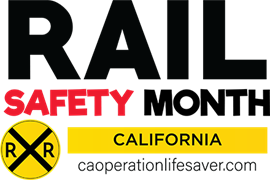Automated External Defibrillators (AEDS)
There is an AED located on board every Metrolink train operating systemwide. An AED is a portable electronic device that automatically can diagnose certain life-threatening cardiac conditions and can treat them through the application of electricity. To view the Red Cross AED demonstration video, click here.
California Operation Lifesaver
Increasing the awareness of the potential dangers that exist at highway-rail grade crossings is an integral component of our safety education program. Therefore, we partner with California Operation Lifesaver to maximize our impact on preventing highway rail grade crossing collision and trespass prevention.
California Operation Lifesaver’s mission is to end collisions, deaths and injuries at highway-rail grade crossings and on rail property through a nationwide network of volunteers who work to educate people about rail safety.
California Operation Lifesaver regularly provides speakers on railroad safety to visit with community groups, motorists, emergency responders, schools and professional drivers. To request a speaker, please visit California Operation Lifesaver at caoperationlifesaver.com.
Incident Reduction Task Force
The Incident Reduction Task Force (IRTF) meets regularly to share data and analyze risk with a mission to reduce railroad ROW incidents in Southern California through community partners’ collaboration, focusing on long-term solutions. The IRTF combines the resources and expertise of Authority staff, local law enforcement, social services, and Member Agencies to develop mitigation strategies to assist in preventing incidents.


